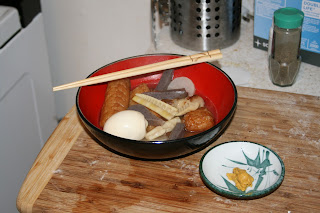It finally turned cold here in central Texas last week, and even then it's short lived - we'll be in the middle sixties by the end of the week. Being from a more northerly clime, I greatly enjoy these bursts of cold (sometimes foul) weather more than some of my neighbors (okay, most of them).
Due to the cold weather last night and an overabundance of desire to do so, I made more curry today. Most of the days between blog posts are taken up with other foods - misoni pork, oden and other nimono, the odd pizza or bowl of ramen - but this felt like it was going to be a curry day. I'm assuming it was on my mind because of both the cold weather and this video the Wife sent me last week. We had discussed making some changes to our home curry recipe, a la JMSDF ships and their post WWII traditions.
Just like everyone's grandma's way of making pot roast or mama's spaghetti sauce secrets, every ship's cook in the JMSDF has a specific way in which they make curry sauce. Curry sauce (as I explained briefly before) was introduced by the British in the late 1800s, then morphed over the course of time to become so popular that it's now considered a national dish. In the early parts of the 1900s, the IJN began a practice that would become a weekly tradition. Ships would have lots of scraps of vegetables and meat saved up from cooking during the week, and various other things that needed some use: tomato sauce, worchestershire sauce, bread crumbs, you name it it was possibly in the galley. Cooks would make curry rice based upon these leftovers and sundry herbs and spices, all made in a thick lard-and-flour-based gravy.
After WWII, the dish continued to skyrocket in popularity to the point where in the 1960s when viable 'roux blocks' of curry began to be sold in supermarkets. Suddenly, you didn't have to spend hours mixing your own sauce and tending the stove twice (or three times if you still used a traditional rice pot) in order to make what was really a simple dish, if you even knew how to make it.
So I did some of my prep last night by chopping up some veggies and mixing my dry spices and flour. Instead of my usual mix of straight curry powder and flour, I went with curry powder, garam masala and flour. This morning, I made some quick beef stock (I have got to get rid of this free instant broth somehow), made my roux block, and sautéd the vegetables and beef in butter before the usual steps of adding and boiling the beef stock, then adding the roe and letting it start to thicken.
This is where things took their second different turn: I added about five tablespoons of Bulldog chuno sauce, three tablespoons of honey and half of an apple's worth of apple puré (made directly over the pot with an oroshigane. After simmering for about forty-five minutes, it was ready to eat.
Super spicy by Japanese standards, yet sweet and a little lighter than usual, it tastes like I'd imagine a combination of Java-brand super hot curry would if you mixed it with House-brand Vermont curry. Next time, I think I'll put some puréd tomatoes and maybe a little less garam masala in. Eventually, we'll find a mix that is specifically our home version. When that day comes, I'm not going to share it openly!
Final Ingredients:
5 cups beef stock
1/2 cup lard
2 Tbs butter
5 Tbs S&B Curry Powder
1 Tbs Garam Masala
5 Tbs Bulldog Chuno Sauce
3 Tbs Honey
4 Tbs Unsweetened Applesauce
2/3 Onion, finely chopped
1 1/2 Carrot, finely chopped
1 lb Beef Stew Meat, fine cut




